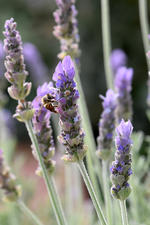Yield - Litres of oil per hectare per year

Conservative
English Lavender Dry flowers: 1 tonnes
Lavandin Dry flowers: 3 tonnes
English Lavender Oil: 8 litres
Lavandin Oil: 30 litres
Average
English Lavender Dry flowers: 2 tonnes
Lavandin Dry flowers: 5 tonnes
English Lavender Oil: 15 litres
Lavandin Oil: 60 litres
Good
English Lavender Dry flowers: 4 tonnes+
Lavandin Dry flowers: 10 tonnes+
English Lavender Oil: 20 litres+
Lavandin Oil: 150 litres+
Harvesting
Harvesting of lavender is done both manually and mechanically depending on the size of the operation. On smaller production units it is done by hand on larger units mechanically.
Dry production: For dried lavender production, cutting can be started as soon as there are enough flowers to be harvested.
Essential oil production: The best essential oils come from harvesting and distilling the lavender flowers just before they go into full flower when the oils in the plant are at their most pungent. Full production can be expected from the second and third years.
Storage
Essential oil: Store bottled essential oils in a dry dark and cool place for about a year to 18 months after bottling. It is best to use dark glass bottles to reduce light pollution of the oil. Older oils start to lose their effectiveness and scent.
Pests and Diseases
Lavender has no real pests and diseases as the strong pungent scent of lavender acts as an insect repellent. It is, however, best to follow a crop protection regime prescribed by an extension officer or agronomist. The local chemical salesmen generally have the right programs or could provide information as to the best advisors available in close proximity to the production area.
Root rots should be guarded against and are caused by waterlogged soil in the root zone.